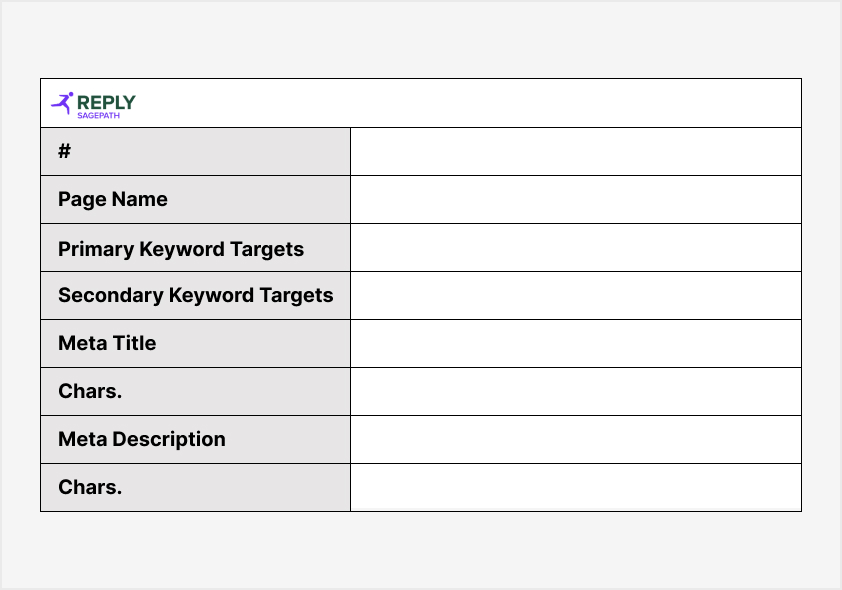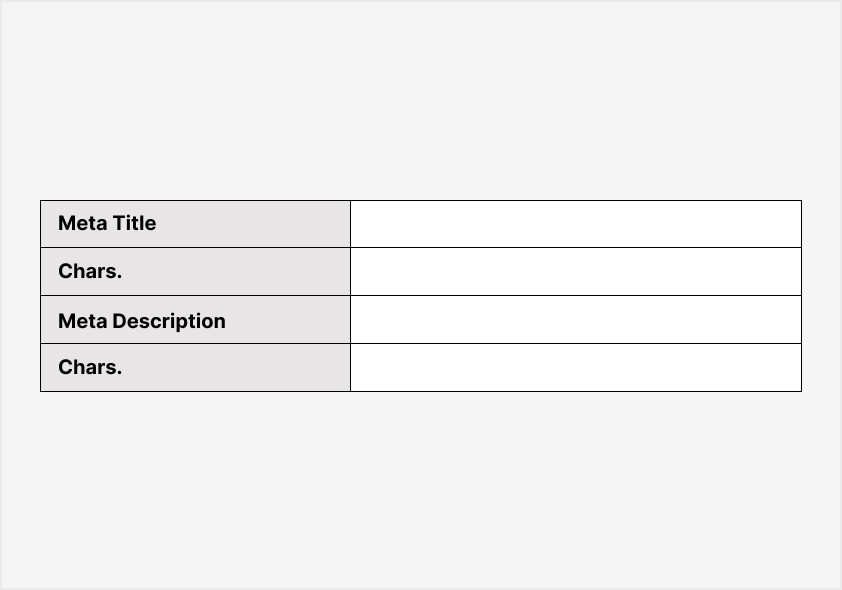Why Keyword Mapping is Crucial for Organic Visibility

Are you having issues with keyword rankings and keyword cannibalization? Are you struggling to drive organic traffic to your pages and blogs? Keyword mapping offers a specialized solution to ensure the best keywords to drive traffic to your website are being used strategically.
What is SEO Keyword Mapping?
Keyword mapping is selecting specific keywords for each page on your website to improve its visibility in search results. This process involves identifying relevant keywords that accurately represent the content of each page.
By strategically placing these keywords throughout the page, you can increase the likelihood of your website appearing in search engine results. This practice is essential for optimizing your website's search engine performance. It's more than just choosing random keywords; it's about understanding search intent, analyzing search volume, and creating a roadmap for organic traffic growth.
Benefits of Keyword Mapping
- Improved Site Structure: Keyword mapping enhances your website's architecture by organizing content around target keywords, making it easier for search engines to crawl and index.
- Enhanced User Experience: By aligning content with search intent, keyword mapping ensures visitors find what they want, leading to higher engagement and conversions.
- Increased Organic Traffic: Targeting the right keywords boosts your website's visibility in search results, driving more organic traffic to your site over time.
- Optimized Internal Links: Keyword mapping facilitates the creation of relevant internal links, improving navigation and distributing link equity effectively throughout your site.
How to Create a Keyword Map
We start by identifying seed keywords relevant to your business by conducting in-depth keyword research. We analyze search terms, volume, intent, and difficulty, and uncover similar keywords that align with your SEO strategy. By understanding search intent, we craft a comprehensive list of keywords tailored to your audience.
Next, we map these keywords to relevant pages on your website, ensuring each page targets specific search queries effectively. This strategic approach minimizes keyword cannibalization and maximizes the chances of ranking higher in search results.
Targeting the same keyword across multiple pages can negatively impact your ability to rank. By targeting different keywords across different pages, you ensure there is no internal competition between your pages.
Our Keyword Mapping Approach
At Sagepath Reply, we believe in a data-driven approach to keyword mapping. Typically after first completing an SEO audit, our team conducts thorough research to identify the most relevant keywords for your business. We analyze search volume, competition, and search trends to develop a comprehensive keyword map tailored to your goals.
Each keyword map includes every page on your website that has organic ranking potential. Authenticated content is irrelevant to SEO for several reasons:
- Search engines prioritize accessibility and indexability, and prefer content they can easily crawl and understand.
- Search engines can't index content that is behind a login.
- Authenticated pages are often personalized to a specific user. This results in different content experiences for each visitor. Search engines want to give all users helpful search results. Gated content doesn't fit this goal because it limits who can access it.

What's Included in a Keyword Map?
Typically delivered via an Excel spreadsheet, every good keyword map should include the following:
- Page Number: Using the current or updated taxonomy of your website, each page follows a numbering structure that allows you to easily understand any parent-child page relationships.
- Page Name: This will typically be the title of your page. Page and blog titles should be optimized for your primary target keyword, as they use the most important on-page heading tag, the H1.
- Primary Target Keyword(s): The main keyword(s) your audience is searching for that would most likely allow your page or blog to appear in organic search. Depending on keyword research and search intent, primary target keywords might be either short tail (on or two words) or longtail (three words or more).
- Secondary Target Keywords: Additional keywords that are closely related to your primary keyword and relevant to your copy. These often include synonyms, longtail variations like "question keywords", and subtopics. Secondary target keywords are often used within H2s and H3s, body copy, and image alt text.
- Optimized Meta Title: A meta title is a clickable link that appears in search engine results. Using target keywords in your meta title helps tell search engines that your page is a good match for the user's query.
- Optimized Meta Description: Although not a direct ranking factor, meta descriptions are important because they provide searchers with an understanding of what to expect when they click through to your page. Meta descriptions should include the primary keyword for your page to encourage users to click. Google will often bold words in your meta description that match or are synonymous with a user's query.
- Optimized URL: Keyword usage in your URL can also act as a ranking factor and should lead with - or at the very least include - your primary target keyword. Optimized page URLs shouldn't include uppercase letters, non-ASCII characters, or underscores.
Pro Tip: Add Character Counters and Conditional Formatting
To ensure your meta titles and meta descriptions align with character count best practices, create a character counter column after both your meta title and meta description columns in your keyword map. Want to take it a step further? Add conditional formatting to automatically highlight any metadata that is either too long or too short.
How to Add Character Count Cells
Excel makes it easy to apply a character counter to any cell or range of cells. In this case, we are going to add our character count columns to the right of both our meta title and meta description columns.
Add two columns – one to the right of your meta title column, and one to the right of your meta description column. Please note: Image below does not show character count cells next to metadata cells due to poor resolution of the original image.

This next step you’ll have to do for each character count column. Click the first empty cell in your first character count column.
Enter “=LEN( ”. To add a cell after your open parenthesis, click the first empty cell in your meta title column. You should see the cell populate next to your open parenthesis in blue. Then add a closed parenthesis and hit “Enter”. This should now appear as a zero.
Finally, copy the cell containing the equation, select all the cells in your column that you want to apply the character counter to, and paste.
Repeat this for your meta description character counter column.
How to Add Conditional Formatting to Character Count Cells
Select all cells in the column that have your character count equation applied.
Click “Conditional Formatting” in the ribbon. Hover over “Highlight Cell Rules”, then click “Greater Than...”.

This will open the Conditional Formatting rules. Under “Apply to range”, you should see the range of cells you selected. Below the “Greater than” drop-down, enter your number – this will be 60 for your meta title character count column or 155 for your meta description character count column. Then click the green button in the lower right corner to apply.

Test it out! If you got it correct, you should see the character count cells automatically apply your Conditional Formatting rules to any metadata that goes beyond the acceptable character count.

Always Follow SEO Metadata Best Practices
Meta titles should be between 50 and 60 characters, but absolutely no longer than 60 characters. Meta titles longer than 60 characters will typically be rewritten by Google, or could simply get cut off. This creates a poor user experience.
Meta descriptions should be no longer than 155 characters, but no shorter than 70. Meta descriptions beyond 155 characters will be truncated or rewritten, taking away your opportunity to entice a user to click through to your page directly from SERPs. Meta descriptions shorter than 70 characters might not fully or clearly explain to a searcher what to expect if they click through to your page.
Measuring Keyword Visibility Success
After putting in all of this work, it's important to understand the impact and success of your keyword targeting.
To calculate your keyword visibility:
- Pull your keyword rankings from an SEO tool, like Semrush. To do this, go to Semrush, select the Organic Research tool, enter the exact URL of your webpage, and click "Search". (Note: If the URL you're trying to measure has child pages, you must select "Exact URL" from the drop-down. This is directly to the right of your URL at the top of the Organic Research results page.)
- Estimate a CTR for each keyword ranking position. This is pretty advanced SEO stuff, but one way is to check the Traffic Percentage column for each keyword and divide that into your total monthly organic traffic estimate. (Note: If you have multiple keywords driving traffic, repeat step two for each keyword.)
- Combine the total number of estimated CTRs
- Divide the total number of CTRs by the total number of keywords.
Interested in Our Keyword Mapping Services?
Contact us today to learn how our SEO experts can transform your website with strategic keyword mapping. Need something else? Check out all of our SEO services for businesses like yours.
About The Author:
Dylan Goldman, Sr. SEO & GEO Manager | Sagepath Reply
Dylan is a search engine optimization (SEO), content strategist and copywriter with over 15 years of experience helping enterprise brands increase their organic visibility and drive measurable growth. Working with Fortune 500 and 1000 companies, he specializes in keyword research and optimization, technical SEO, schema markup, and high-level content strategy. Dylan is also leading initiatives in Generative Engine Optimization (GEO), helping organizations prepare their content for AI-driven search experiences and emerging answer engines.

Let’s Start a Conversation
Reach out to discuss your digital transformation needs and see how we can help. We would love to start a long-term partnership with your company.
Get in Touch


